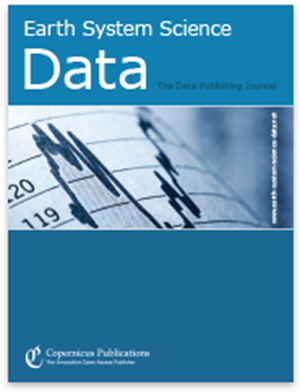First release of the Pelagic Size Structure database: global datasets of marine size spectra obtained from plankton imaging devices
IF 11.6
1区 地球科学
Q1 GEOSCIENCES, MULTIDISCIPLINARY
引用次数: 0
Abstract
Abstract. In marine ecosystems, most physiological, ecological, or physical processes are size dependent. These include metabolic rates, the uptake of carbon and other nutrients, swimming and sinking velocities, and trophic interactions, which eventually determine the stocks of commercial species, as well as biogeochemical cycles and carbon sequestration. As such, broad-scale observations of plankton size distribution are important indicators of the general functioning and state of pelagic ecosystems under anthropogenic pressures. Here, we present the first global datasets of the Pelagic Size Structure database (PSSdb), generated from plankton imaging devices. This release includes the bulk particle normalized biovolume size spectrum (NBSS) and the bulk particle size distribution (PSD), along with their related parameters (slope, intercept, and R2) measured within the epipelagic layer (0–200 m) by three imaging sensors: the Imaging FlowCytobot (IFCB), the Underwater Vision Profiler (UVP), and benchtop scanners. Collectively, these instruments effectively image organisms and detrital material in the 7–10 000 µm size range. A total of 92 472 IFCB samples, 3068 UVP profiles, and 2411 scans passed our quality control and were standardized to produce consistent instrument-specific size spectra averaged to 1° × 1° latitude and longitude and by year and month. Our instrument-specific datasets span most major ocean basins, except for the IFCB datasets we have ingested, which were exclusively collected in northern latitudes, and cover decadal time periods (2013–2022 for IFCB, 2008–2021 for UVP, and 1996–2022 for scanners), allowing for a further assessment of the pelagic size spectrum in space and time. The datasets that constitute PSSdb's first release are available at https://doi.org/10.5281/zenodo.11050013 (Dugenne et al., 2024b). In addition, future updates to these data products can be accessed at https://doi.org/10.5281/zenodo.7998799.首次发布远洋尺寸结构数据库:从浮游生物成像设备获得的全球海洋尺寸光谱数据集
摘要在海洋生态系统中,大多数生理、生态或物理过程都与大小有关。这些过程包括新陈代谢率、对碳和其他营养物质的吸收、游动和下沉速度、营养相互作用(最终决定了商业物种的存量)以及生物地球化学循环和碳封存。因此,对浮游生物大小分布的大尺度观测是人类活动压力下浮游生态系统总体功能和状态的重要指标。在此,我们展示了浮游生物尺寸结构数据库(PSSdb)的首批全球数据集,该数据库由浮游生物成像设备生成。此次发布的数据集包括由三种成像传感器(成像流式细胞仪(IFCB)、水下视觉剖面仪(UVP)和台式扫描仪)在上浮游层(0-200 米)内测量的大颗粒归一化生物体积粒度谱(NBSS)和大颗粒粒度分布(PSD)及其相关参数(斜率、截距和 R2)。总体而言,这些仪器能够有效地对 7-10 000 µm 尺寸范围内的生物和碎屑物质进行成像。共有 92 472 份 IFCB 样品、3068 份 UVP 剖面图和 2411 次扫描通过了我们的质量控制,并进行了标准化处理,以产生一致的仪器特定尺寸光谱,按 1° × 1° 的经纬度和年月进行平均。我们的特定仪器数据集跨越了大多数主要大洋盆地,但我们所摄取的 IFCB 数据集除外,这些数据集仅在北纬采集,并覆盖了十年的时间段(IFCB 为 2013-2022 年,UVP 为 2008-2021 年,扫描仪为 1996-2022 年),从而可以在空间和时间上对远洋大小谱进行进一步评估。构成 PSSdb 第一版的数据集可在 https://doi.org/10.5281/zenodo.11050013 上查阅(Dugenne 等,2024b)。此外,这些数据产品的未来更新可在 https://doi.org/10.5281/zenodo.7998799 上查阅。
本文章由计算机程序翻译,如有差异,请以英文原文为准。
求助全文
约1分钟内获得全文
求助全文
来源期刊

Earth System Science Data
GEOSCIENCES, MULTIDISCIPLINARYMETEOROLOGY-METEOROLOGY & ATMOSPHERIC SCIENCES
CiteScore
18.00
自引率
5.30%
发文量
231
审稿时长
35 weeks
期刊介绍:
Earth System Science Data (ESSD) is an international, interdisciplinary journal that publishes articles on original research data in order to promote the reuse of high-quality data in the field of Earth system sciences. The journal welcomes submissions of original data or data collections that meet the required quality standards and have the potential to contribute to the goals of the journal. It includes sections dedicated to regular-length articles, brief communications (such as updates to existing data sets), commentaries, review articles, and special issues. ESSD is abstracted and indexed in several databases, including Science Citation Index Expanded, Current Contents/PCE, Scopus, ADS, CLOCKSS, CNKI, DOAJ, EBSCO, Gale/Cengage, GoOA (CAS), and Google Scholar, among others.
 求助内容:
求助内容: 应助结果提醒方式:
应助结果提醒方式:


